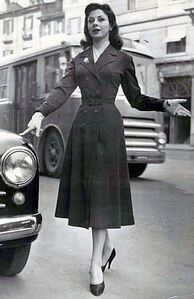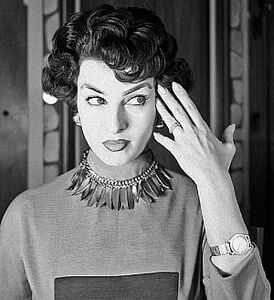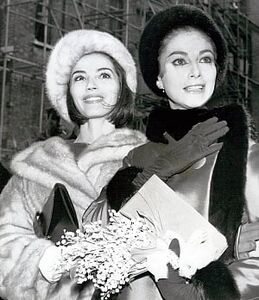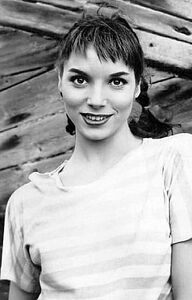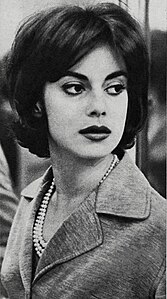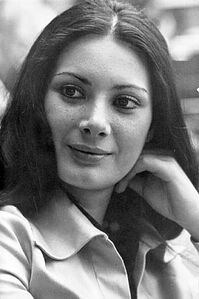Banda italiana
The banda italiana (Italian for "Italian gang") is a nickname given to a group of Gylian actors of Italian descent who frequently worked together in many films in the 1960s and 1970s. Famed for its tight-knit camaraderie and humorous playing with Italian stereotypes, the group is usually considered to include Carla Miló, Silvana Perriello, Les Myas, Elsa Martinelli, Anna Maria Guerra, and Edwige Ferré. Additional members were directors Vittorio Marchi and Paolo Giussani.
Origins
The term was first used in a L'Petit Écho article from 1965, written by Hélène Marron. Hélène was originally supposed to interview just Carla, but one night, Carla invited her friends to hang out at a local nightclub. It was a typical night out for the group, and it impressed Hélène, who changed the focus of the article to the entire group.
When the article was published, the group was greatly pleased with it, since it portrayed them positively and devoted much of its focus to profiling their group dynamic. More importantly, while the members had been considered talented figures in Gylian cinema before, the article helped crystallise a group identity, which boosted the profiles of the then-lesser known Edwige and Anna. After its publication, the group consciously played up the image of the tight-knit clique created by L'Petit Écho.
Another humorous name applied to the group was squadra dei cappelli neri ("Black hair squad"), because all the actresses in it had black hair. This nickname particularly amused Elsa Martinelli and Anna Maria Guerra, who had served as conscripts in the Cacertian Armed Forces. A less common nickname was le streghe ("the witches"), which Silvana complained was inaccurate since not all of them practiced Megelanese witchcraft.
Members
The core members of the banda were the following actresses:
Les Myas
(Maria Anna and Maria Luisa Picarelli)
Additional members of the group were directors Vittorio Marchi (Carla's husband) and Paolo Giussani (Rauna Næsve's husband).
The original L'Petit Écho article implied Carla was the leader of the group, humorously describing her as the "chief rooster of the hen house" — alluding to her existing nickname La Gallona. Her friends found the characterisation amusing, and realistic since Carla tended to be the one with the most initiative, and it influenced the group's dynamics as Carla took a definite leadership role.
Les Myas were unique among the group as primarily musicians who pursued acting careers. On the other hand, Carla, Silvana, and Anna were actors who recorded music. Silvana had released singles before relocating to Gylias; Carla's were the most successful despite her lack of vocal training, as she chose material that matched her gallista image and simply performed her routines to a jazz backing.
In terms of origin: Carla, Silvana, Les Myas, Edwige, and Vittorio were of Megelanese descent, and Elsa, Anna, and Paolo were of Cacertian descent. Carla was born into a Free Megelanese family in Alscia, and Edwige was born in the Free Territories. The rest were born in their respective countries and traveled for work later.
The group formed several inside jokes. Carla was usually addressed simply by her nickname La Gallona. The others would address Elsa with humorously exaggerated politeness as Signora Martinelli ("Ms. Martinelli") due to her elegant image, which inspired the title of the documentary Cosa vuole la signora Martinelli? ("What does Ms. Martinelli want?").
Work
The banda was famous for its tight-knit camaraderie. Its members regularly socialised together and worked on each other's films. It was common for a member who got a role in a film to try to secure a cameo appearance for at least one of their friends. Silvana, as the director of her films, was one of the most prolific collaborators, and the most likely to gather as much of her fellow bandieri as possible into a film. Paolo did the least work with the rest of the group because he worked exclusively with his wife Rauna Næsve. Carla's similarly exclusive collaboration with her husband Vittorio was an easier fit for the group.
The bandieri developed distinctive character types through their experience in Gylian cinema:
- Carla's gallista characters satirically embodied traits of male chauvinism.
- Silvana played hot-tempered and arrogant yet witty bombshells, whose bullheaded determination gave them an odd integrity.
- Les Myas generally played ingénue roles similar to Alike Demetriou and Máiréad Ní Conmara.
- Elsa often favoured "cute" roles, counterbalanced by her refined personality.
- Anna tended to specialise in aloof, sarcastic, and formidable characters.
- Edwige's roles were less defined, as she didn't come up with her iconic poliziotta character until later, but they generally focused on her physical attractiveness.
The members mainly worked in comedy, but their styles were sufficiently flexible to accomodate various subgenres, from slice of life storytelling to genre fiction. Vittorio observed:
"One of the joys of working together was getting their characters to play off each other — you could see Carla trying to be a manly mentor to Elsa, matching wits with Anna, or making fun of Silvana without her realising, depending on the movie. The Marias could be counted on to play the oddly mature kids baffled by all the adult insanity going on around them."
Stylistically, Carla stood out among the group for her trademark use of playfully boastful narration and fourth wall-breaking asides, techniques that were absent from the others' films.
The bandieri did much of their work in Gylias, but regularly traveled to Megelan and Cacerta for work as well. Of the group, Carla worked in Gylias the most, while Silvana traveled to Megelan the most, taking advantage of her existing citizenship. Elsa commented in 1970 that she could "go to Cacerta for a few months, star in dramas or what comes my way, and then go to Gylias and reassemble the witches' coven." Edwige found herself in unexpected demand for violent Megelanese horror and thriller films, where she described her roles as "the girl the audience falls in love with at the start—and probably lust as well—and somehow manages to survive the mayhem intact. I think they found it funnier to have me get out of danger through blind luck."
Later careers
The group's peak is considered to have ended in 1973, when Carla retired from making gallista comedies. The actors continued to work together and socialise, but since Carla had been the driving force behind the group, without her initiative the group's activity and profile began to fade.
Notably, Edwige achieved greater fame in pornography after launching her La Poliziotta series in 1976, after mainly playing second fiddle roles in the group's heyday.
Impact
Italianità
The banda italiana achieved stardom and became the outstanding Italian voices in Gylian cinema and pop culture. Carla was the driving force behind the group embracing the status of Gylias' most prominent Italians, and they became known for their tongue-in-cheek boosterism of Italian culture and playing with Italian stereotypes in their films. They borrowed these methods from the francité movement, whom they considered natural allies.
Gylias Review wrote that the bandieri "seized on Italian stereotypes and turned them into points of pride and objects of lust, positing that Italian-ness itself was sexy." Their character types encompassed the spectrum of traits associated with Italian identity, from Elsa's elegance and Les Myas' appealing innocence to Carla's boastfulness, Anna's haughtiness, and Silvana's cantankerous bon mots. Some of their films openly referred to francité, with humorous plots in which a protagonist (usually Elsa, Les Myas, or Edwige) desires to become "more Italian" and thus seeks out an italianità mentor (usually Carla, Silvana, or Anna), with comical results.
While the group prioritised pan-Italian solidarity in its œuvre and public image, the majority of its members were of Megelanese descent, and thus they inadvertently enforced the popular perception of an Italian "division of labour" which associated Cacerta with high culture and Megelan with low culture. At least one of their films parodied this "division of labour" through the plot of a hapless suitor torn between the rambunctious Carla (representing Megelan) and the aristocratic Anna (representing Cacerta) — the twist being that both Carla and Anna are quietly working together to ensure they both win.
As the leading Italian voices in pop culture during the Golden Revolution, the banda italiana were greatly influential and set a precedent for popular representation of Italian identity which would be followed by future Italian cultural figures, most notably Moana Pozzi, considered one of the first Italian Gylians to break from the mold of the squadra dei cappelli neri.
Clarissa Rossetti, the equality minister in the Darnan Cyras government, commented in Nation Building:
"The bandieri were very clever, very careful to couch their italianità in jokes, to avoid the risk of getting on people's nerves. Still, under those jokes, they managed to win great sympathy among the public concerned about protecting l'belle mosaïque. They shared Elsa's horror in recounting her nightmare, 'I walked down the streets of Vichenza and all I could hear was English!'"
Groups
The banda italiana's tight-knit camaraderie and conscious Italian-ness fascinated the Gylian media. It would inspire a similar interest in later groups or scenes marked by similar solidarity and well-defined identity, ranging from shoegazing in music, the "Boulevard des Communards clique" in cinema, or even the Tetramazones in politics.
Nora Gunnarsen would later describe the banda as a foremost example of "Gylians' enduring fascination with small, powerful groups that plant their flag in a corner of pop culture and achieve an impressive, outsized impact", attributing it to "the tendency to conceive of culture as a mass of equal subcultures coexisting peacefully with no monopolies", analogous to the myriad members of the National Cooperative Confederation. This perspective was echoed by Silvana, who once joked that the banda did its best to function like a Megelanese guild.
International
The banda italiana was a prominent example of pan-Italian solidarity and cooperation across Gylias, Cacerta, and Megelan in its era.
Their work in Megelan led to the creation of a mini-scene that was described as movies "made by the Megelanese, for the Gylians". These were notably one of Megelan's first successful exports, presaging later boom periods in Megelanese cinema.
